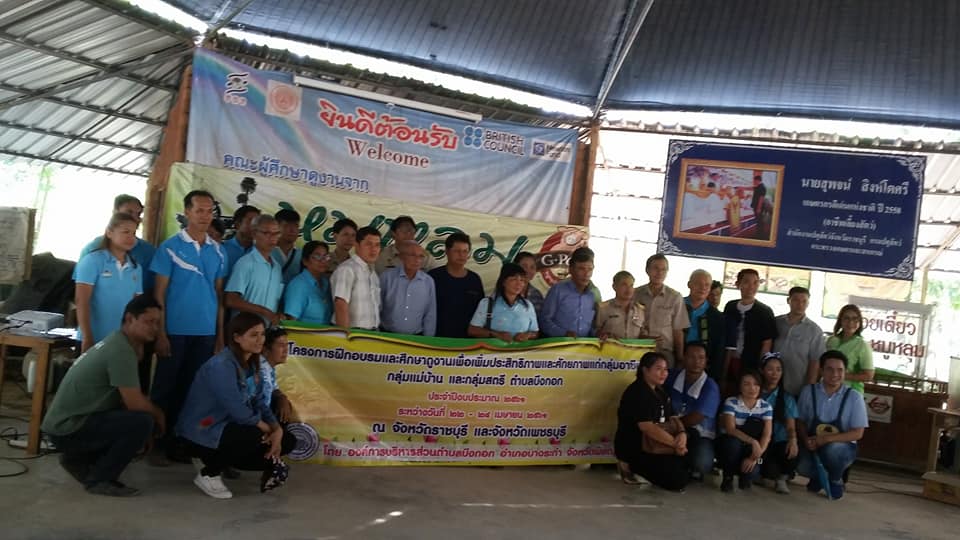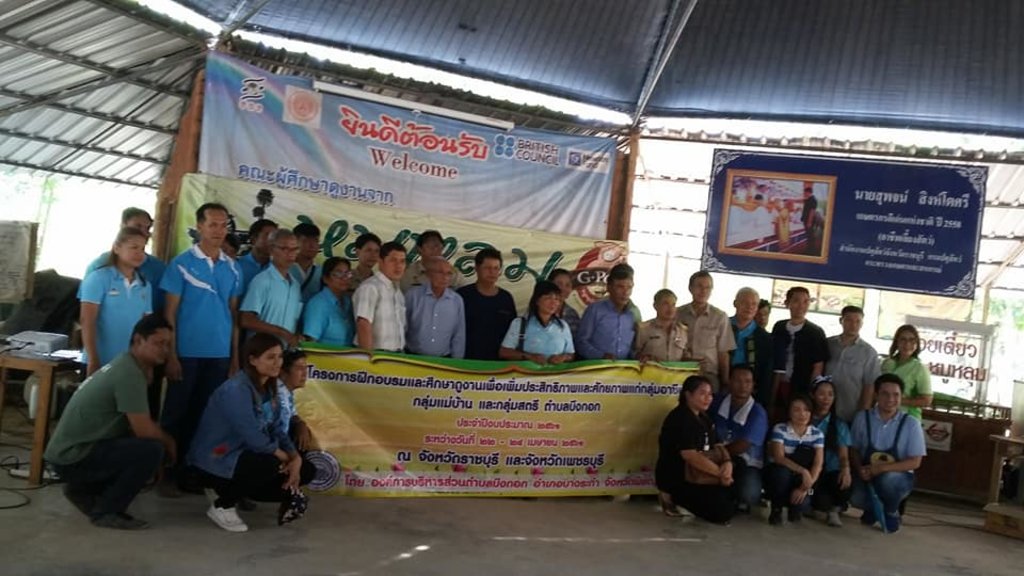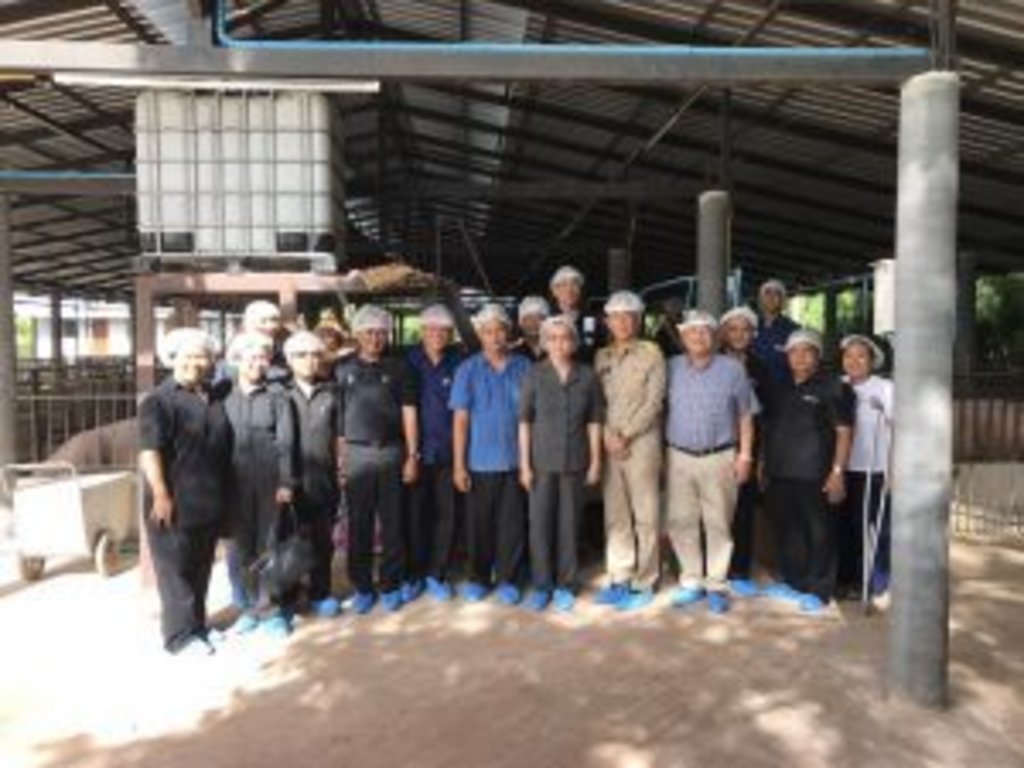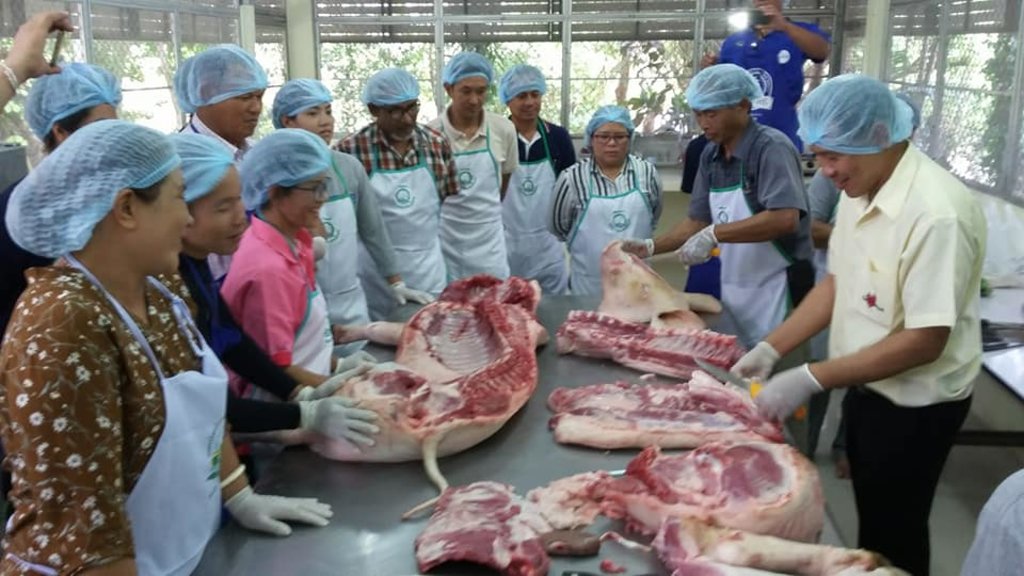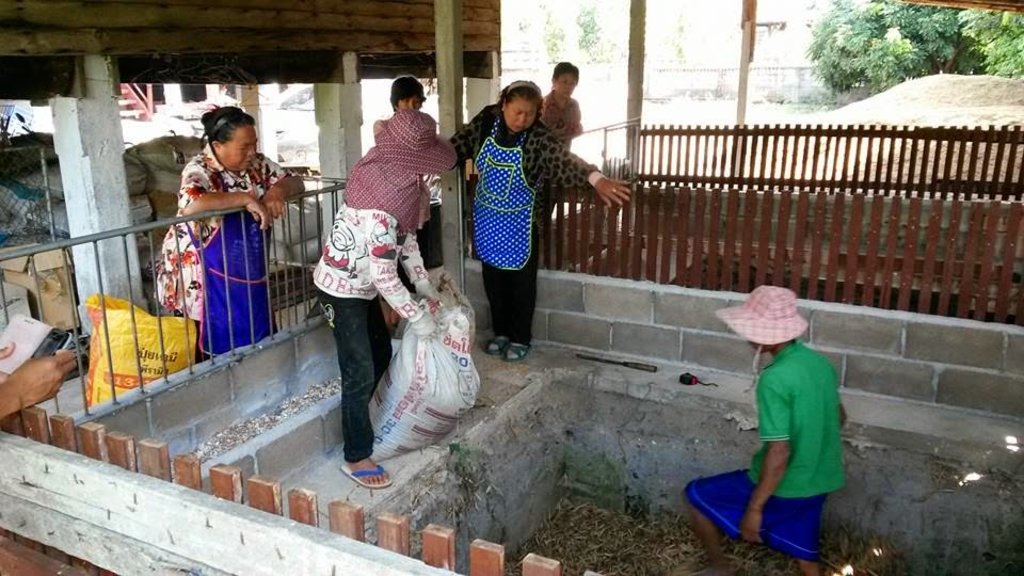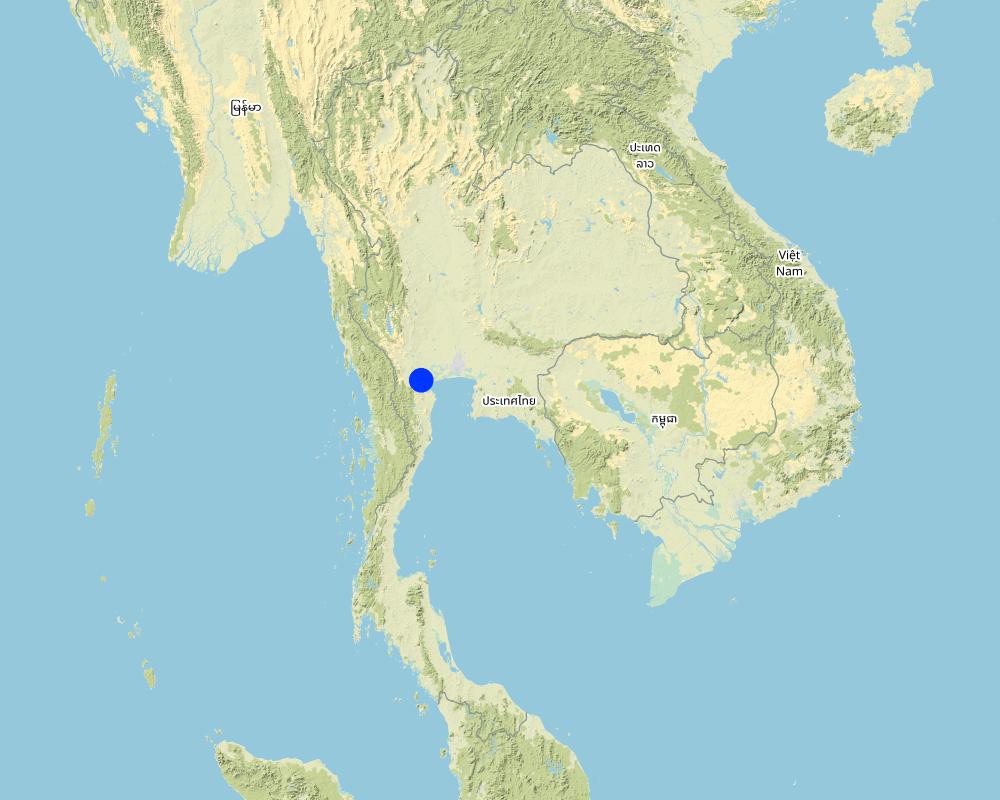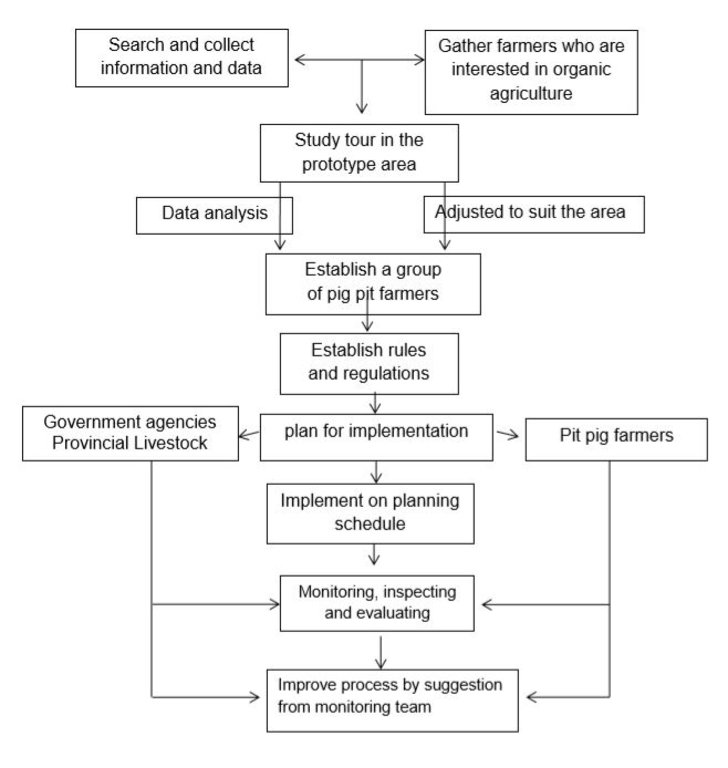Moo Lum Zero-Waste Pig Farm Technology Transfer (Thailand) [Thailand]
- Creation:
- Update:
- Compiler: Kukiat SOITONG
- Editor: –
- Reviewers: William Critchley, Rima Mekdaschi Studer, Joana Eichenberger
-
approaches_4253 - Thailand
View sections
Expand all Collapse all1. General information
1.2 Contact details of resource persons and institutions involved in the assessment and documentation of the Approach
Key resource person(s)
co-compiler:
ผู้รวบรวม:
- ทีมสำนักงานพัฒนาที่ดินเขต10
032-320929 / -
- / -
Region 10 Land Development Office
196 Moo11 Hinkong Muang District Ratchaburi province 70000
Thailand
land user:
Singtosri Supoj
086-8050749 / -
supojkb@gmail.com / -
Moo Lum Farmer group
95/1 Moo 9 Tambon DonRae Muang District Ratchaburi province.70000
Thailand
land user:
Kitisorn Prasert
087-9928353
- / -
-
33/1....Moo 10 Tambon DonRae Muang District Ratchaburi province.70000
Thailand
land user:
Huangthong Somnuk
081-1930988 / -
- / -
-
25….Moo 9 Tambon DonRae Muang District Ratchaburi province.70000
Thailand
land user:
Bhuddha Wanpen
083-4299299 / -
- / -
-
.8 .Moo 10 Tambon DonRae Muang District Ratchaburi province.70000
Thailand
1.3 Conditions regarding the use of data documented through WOCAT
The compiler and key resource person(s) accept the conditions regarding the use of data documented through WOCAT:
Yes
1.4 Reference(s) to Questionnaire(s) on SLM Technologies
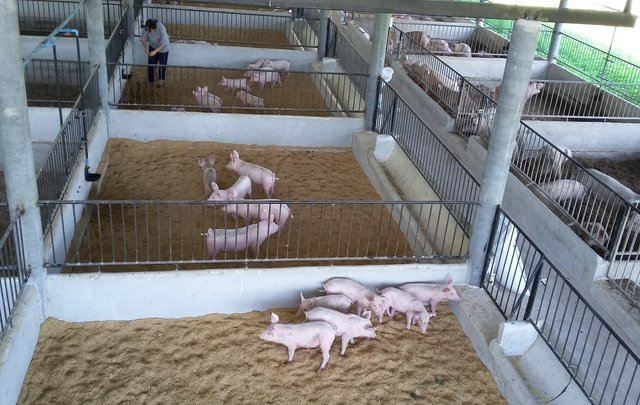
Moo Lum Pig Farming: A Zero-Waste Management Technology [Thailand]
The Zero-Waste Pig Farm or Moo Lum is the integrated management of pigs in pens with the use of microorganisms that lead to the safety of pork products. This technique has become beneficial, as the pig waste can be used as organic fertilizer that produces no pollution to the community.
- Compiler: Kukiat SOITONG
2. Description of the SLM Approach
2.1 Short description of the Approach
Moo Lum Zero-Waste Pig Farm Technology Transfer Center is a center of learning and knowledge transfer from successful farmers to others, as well as helping to build a network of Moo Lum zero-waste pig farmers to exchange knowledge and learn to solve their problems together.
2.2 Detailed description of the Approach
Detailed description of the Approach:
The approach of the Moo Lum Zero-Waste Pig Farm Technology Transfer Center is to form groups of farmers/ people engaged in Moo Lum pig farming with an emphasis on
transfer of the technology. It also serves to build a network of Moo Lum zero-waste pig farmers to exchange knowledge and learn to solve their problems together, especially to increase their marketing capabilities. The functions of the Center are (a) to organize seminars to promote the exchange of knowledge about breeds, nutrition, management and marketing and (b) to establish an agricultural group around Moo Lum pig farming that has sufficient output for the market to empower negotiation, and to make it easier to access capital. Furthermore it is engaged in creating a network in the province and to make links with other provinces countrywide in order to increase the strength of the groups. The activities of the Centre are as follows:
1. Provide various training courses.
2. Invite farmers engaged in old-style pig farming to set up groups and exchange
knowledge about the approach.
3. Establish a technology transfer center for pig farming.
4. Provide a knowledge transfer process from the practical situation.
5. Outreach to Youtube, videos, brochures, TV and radio interviews.
6. Create a network of the Moo Lum zero-waste pig farms at the community level, as well
as outside the community, by organizing training once a month.
The key stakeholders are the farmers who play a common role in learning, practicing, exchanging the knowledge, the government agencies - especially the Department of Alternative Energy Development and Energy Conservation - who promote and support the center by provide a budget and inputs and support public relations, as well as the private sector, local government organizations, schools and universities. The farmers that join the center are accepted in the community because they reduce pollution and do not damage the environment. These farmers can sell more to the market because of their safe food products and they have become more popular. They can easily contact public agencies. Grouping the farmers makes the members stronger, as they coordinate and exchange their experience, knowledge, and lend support to each other from time to time. Government agencies are becoming increasingly interested and give technical support to the group. Provincial livestock officers have an important role. The Center has become well known, visitors are coming in increasing numbers, and the public are interested in the safe products from the Moo Lum farmers group. However if the number of Moo Lum farmers increases year by year it will affect the amount of food crops required to feed the pigs. Farmers should be encouraged to grow more feedstock for pig farming and there should be a study on pig food formulation according to the availability of food materials. Also, in general, the price of Moo Lum pork products is not much different from ordinary ones. It might be beneficial to establish a pork standard, so the quality of products in the market will be raised, thus the price of the pork will also increase.
2.3 Photos of the Approach
2.4 Videos of the Approach
Comments, short description:
-
Location:
-
Name of videographer:
-
2.5 Country/ region/ locations where the Approach has been applied
Country:
Thailand
Region/ State/ Province:
Ratchaburi
Further specification of location:
DonRae Sub-district, Muang District Ratchaburi Province, Thailand
Comments:
-
Map
×2.6 Dates of initiation and termination of the Approach
Indicate year of initiation:
2006
If precise year is not known, indicate approximate date when the Approach was initiated:
10-50 years ago
Comments:
Continuous implementation up to present
2.7 Type of Approach
- project/ programme based
2.8 Main aims/ objectives of the Approach
The objectives of the Moo Lum pig farming technology transferring center are to make farmers understand the processes of Moo Lum pig farming, to create a network of pig farmers to help and exchange experiences with each other, and to offer the members of the farmers within the group a chance to exchange lessons and solve problems together.
2.9 Conditions enabling or hindering implementation of the Technology/ Technologies applied under the Approach
social/ cultural/ religious norms and values
- enabling
availability/ access to financial resources and services
- enabling
Sustainable pig farming makes it easier to get financial support.
institutional setting
- enabling
A number of integrated agencies such as Department of Livestock Development, BAAC, Agricultural Extension officers.
collaboration/ coordination of actors
- enabling
Integrated local agencies.
legal framework (land tenure, land and water use rights)
- enabling
The land can be used for pig farming.
policies
- enabling
Public agencies helped push the group to reach the standard production.
knowledge about SLM, access to technical support
- enabling
It enables farmers to cooperate with the public sectors easier.
markets (to purchase inputs, sell products) and prices
- hindering
Not recognized in the market and the price is not different.
workload, availability of manpower
- hindering
Difficult to find skilled labourers.
3. Participation and roles of stakeholders involved
3.1 Stakeholders involved in the Approach and their roles
- local land users/ local communities
Farmers, members of Moo Lum pig farming group at Don Rae Sub-district, Muang District, Ratchaburi Province.
-
- community-based organizations
Sub-district Administration Organization.
-
- SLM specialists/ agricultural advisers
Department of Livestock Development (DLD), Land Development Department (LDD)
-
- teachers/ school children/ students
Student visitors from Agricultural Colleges, Rajabhat Universities
-
- private sector
May support in the matters of budget and public relations
-
If several stakeholders were involved, indicate lead agency:
-
3.2 Involvement of local land users/ local communities in the different phases of the Approach
| Involvement of local land users/ local communities | Specify who was involved and describe activities | |
|---|---|---|
| initiation/ motivation | self-mobilization | Government agencies, farmer group members, make field visit to various places and adapt what they learn to suit their farms. |
| planning | interactive | Government agencies, farmer group members, Provincial Livestock officers participate in planning. |
| implementation | interactive | Public sectors and farmer group members implement the plan. |
| monitoring/ evaluation | interactive | Monitoring and knowledge exchange inside/outside the group of farmers and follow up of public sector as Provincial Livestock officers make products meet the standards. |
3.3 Flow chart (if available)
Description:
The Procedures of the Moo Lum Zero-Waste Pig Farming Technology Transfer Center are as follow:
1. Offer the training for people coming from various places
2. Invite farmers that do the old style pig farming to set up groups and exchange knowledge about the approach.
3. Establish a technology transfer center for pig farming.
4. Provide a knowledge transfer process from the practical situation.
5. Outreach to Youtube, videos, brochures, TV and radio interviews.
6. Create a network of the Moo Lum zero-waste pig farms at the community level, as well as outside the community, by organizing training every third Saturday of the month.
7. Promotion and support through The Department of Agricultural Extension, Land Development Department, Department of Alternative Energy Development and Energy Conservation.
Author:
Ms Kulwadee Satthawas
3.4 Decision-making on the selection of SLM Technology/ Technologies
Specify who decided on the selection of the Technology/ Technologies to be implemented:
- all relevant actors, as part of a participatory approach
Explain:
-
Specify on what basis decisions were made:
- personal experience and opinions (undocumented)
- From Provincial Livestock officers ✓
4. Technical support, capacity building, and knowledge management
4.1 Capacity building/ training
Was training provided to land users/ other stakeholders?
Yes
Specify who was trained:
- land users
- Moo Lum farmers group
If relevant, specify gender, age, status, ethnicity, etc.
Moo Lum farmers group and interested persons
Form of training:
- on-the-job
- farmer-to-farmer
Comments:
Moo Lum farmers group and interested persons
4.2 Advisory service
Do land users have access to an advisory service?
Yes
- Moo Lum farmers group and interested persons
Describe/ comments:
officers advise often
4.3 Institution strengthening (organizational development)
Have institutions been established or strengthened through the Approach?
- no
4.4 Monitoring and evaluation
Is monitoring and evaluation part of the Approach?
Yes
Comments:
Provincial Livestock officers advise the technique to meet the standard
If yes, is this documentation intended to be used for monitoring and evaluation?
No
4.5 Research
Was research part of the Approach?
No
5. Financing and external material support
5.1 Annual budget for the SLM component of the Approach
If precise annual budget is not known, indicate range:
- > 1,000,000
5.2 Financial/ material support provided to land users
Did land users receive financial/ material support for implementing the Technology/ Technologies?
No
5.3 Subsidies for specific inputs (including labour)
- none
Comments:
-
5.4 Credit
Was credit provided under the Approach for SLM activities?
No
5.5 Other incentives or instruments
Were other incentives or instruments used to promote implementation of SLM Technologies?
Yes
If yes, specify:
Continuous support from public sectors
6. Impact analysis and concluding statements
6.1 Impacts of the Approach
Did the Approach empower local land users, improve stakeholder participation?
- No
- Yes, little
- Yes, moderately
- Yes, greatly
Meet the market demand, safe food products, increase production for the market.
Did the Approach enable evidence-based decision-making?
- No
- Yes, little
- Yes, moderately
- Yes, greatly
Can sustainably generate income.
Did the Approach help land users to implement and maintain SLM Technologies?
- No
- Yes, little
- Yes, moderately
- Yes, greatly
Maintain better environment in the community.
Did the Approach improve coordination and cost-effective implementation of SLM?
- No
- Yes, little
- Yes, moderately
- Yes, greatly
Farmers group operates sustainably.
Did the Approach improve knowledge and capacities of land users to implement SLM?
- No
- Yes, little
- Yes, moderately
- Yes, greatly
Public sectors advise and give knowledge, so the knowledge and capacities of land users eventually increase.
Did the Approach improve knowledge and capacities of other stakeholders?
- No
- Yes, little
- Yes, moderately
- Yes, greatly
Yes, the knowledge and capacities of other stakeholders improve similarly.
Did the Approach build/ strengthen institutions, collaboration between stakeholders?
- No
- Yes, little
- Yes, moderately
- Yes, greatly
Yes, it strengthens institutions and collaboration between stakeholders.
Did the Approach encourage young people/ the next generation of land users to engage in SLM?
- No
- Yes, little
- Yes, moderately
- Yes, greatly
Such an occupation might be followed by the next generation too, as they witness what their parents are doing now.
Did the Approach lead to improved food security/ improved nutrition?
- No
- Yes, little
- Yes, moderately
- Yes, greatly
Yes, it leads to safe, chemical-free food products.
Did the Approach improve access to markets?
- No
- Yes, little
- Yes, moderately
- Yes, greatly
It gives an alternative of chemical-free products to consumers.
Did the Approach lead to more sustainable use/ sources of energy?
- No
- Yes, little
- Yes, moderately
- Yes, greatly
It is the biogas that can be produced from the pig waste.
Did the Approach improve the capacity of the land users to adapt to climate changes/ extremes and mitigate climate related disasters?
- No
- Yes, little
- Yes, moderately
- Yes, greatly
Modifying the practice to be environmentally friendly.
Did the Approach lead to employment, income opportunities?
- No
- Yes, little
- Yes, moderately
- Yes, greatly
Some locally hired labour
6.2 Main motivation of land users to implement SLM
- increased production
Increasing consumer demand
- increased profit(ability), improved cost-benefit-ratio
Greater product variety meet the need of consumer
- affiliation to movement/ project/ group/ networks
A number of interested visitors
- environmental consciousness
Smell pollution reduction management
- enhanced SLM knowledge and skills
Be advised from public agencies often
6.3 Sustainability of Approach activities
Can the land users sustain what has been implemented through the Approach (without external support)?
- yes
If yes, describe how:
Because public agencies give the advice, and the recommendation and promotion control make the Moo Lum system guaranteed with a standard.
6.4 Strengths/ advantages of the Approach
| Strengths/ advantages/ opportunities in the land user’s view |
|---|
| The center has been accepted by the community due to producing no pollution and being environmentally friendly farms. |
| Suitable location, being not far from the community and the market |
| The safe products attract more markets interested in them. |
| The grouping as the center makes it easier to communicate with the public sector. |
| Strengths/ advantages/ opportunities in the compiler’s or other key resource person’s view |
|---|
| The strong center provides good communication among members, knowledge exchange forum, helping among members and the participation of the center’s activities. |
| A number of agencies from public and private sectors are interested in and willing to support the center, esp. the Department of Livestock Development. |
| The number of visitors has increased, giving more opportunity to sell safe farm products |
6.5 Weaknesses/ disadvantages of the Approach and ways of overcoming them
| Weaknesses/ disadvantages/ risks in the land user’s view | How can they be overcome? |
|---|---|
| The increasing number of members will affect the availability of local raw materials for farming. | Promoting the community farmers to produce more and adjust the feeding formula to the available materials. |
| Products from a zero-waste farm are not much different from general ones. | Create more understanding to the public and markets. |
| Weaknesses/ disadvantages/ risks in the compiler’s or other key resource person’s view | How can they be overcome? |
|---|---|
| The zero-waste farm products in terms of products and packaging is not modern and not particularly attractive to consumers. | Needs help from the public sector and others. |
| Still needs more development on the zero-waste pig feeding which requires longer time plus related cost. | Needs more research and new technique to reduce the cost. |
| Limited market of the zero-waste standard products, not well known to general consumers. | Needs more PR. |
| The zero-waste pig farm management has not been recognized by a public standard. | Request public agencies to help with the PR. |
7. References and links
7.1 Methods/ sources of information
- field visits, field surveys
-
- interviews with land users
-
7.2 References to available publications
Title, author, year, ISBN:
-
Available from where? Costs?
-
7.3 Links to relevant information which is available online
Title/ description:
-
URL:
-
Links and modules
Expand all Collapse allLinks

Moo Lum Pig Farming: A Zero-Waste Management Technology [Thailand]
The Zero-Waste Pig Farm or Moo Lum is the integrated management of pigs in pens with the use of microorganisms that lead to the safety of pork products. This technique has become beneficial, as the pig waste can be used as organic fertilizer that produces no pollution to the community.
- Compiler: Kukiat SOITONG
Modules
No modules


